2021 Ford Mustang Mach-E Review - Beyond The Badge
- Engaging driving that embraces the best of electric
- Competitively priced
- Spacious cabin with plenty of tech
- Styling is head-turning
- Range isn't as good as Tesla's Model Y
- Public charging infrastructure can be frustrating
- Get ready for interminable "is it really a Mustang?" arguments
Two minutes into driving the 2021 Ford Mustang Mach-E for the first time, I watched a man in a pickup miss his green light because he was too busy staring at the metallic red electric crossover. It set expectations for the reaction I should expect to Ford's new zero-emissions pony car and, though the name may be controversial, one thing became abundantly clear: the appetite for a stylish, competent EV from a company that isn't Tesla is strong.
First things first, I think the Mustang Mach-E looks fantastic. It's smaller in the metal than you expect from pictures, lower and leaner. That leaves the design cues borrowed from Mustang coupes all the more effective: the swollen fenders and squinting LED lights at the front, and the meaty haunches at the rear giving it a sturdy, planted profile.
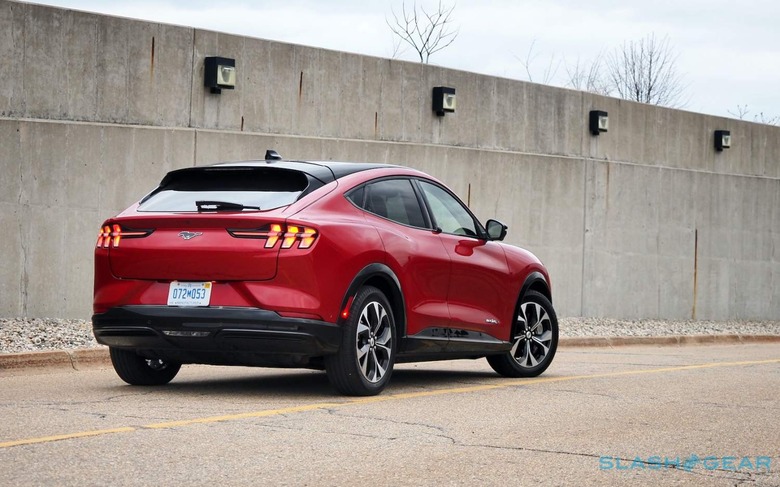
Inside, it feels Ford, but elevated. There's some familiar switchgear, yes, but it all looks and feels cohesive. No squeaks or cheap-feeling plastics.
The whole cabin feels spacious and solid, like it could hold up to actually being used as a crossover for a young family. There's 29.7 cu-ft to play with in the trunk, expanding to 59.7 cu-ft with the rear seats folded, plus 4.7 cu-ft in the front trunk. The latter is washable and has a drain plug at the bottom. Ford uses its ActiveX synthetic leather for the seats, which straddles a neat line between comfort and durability.
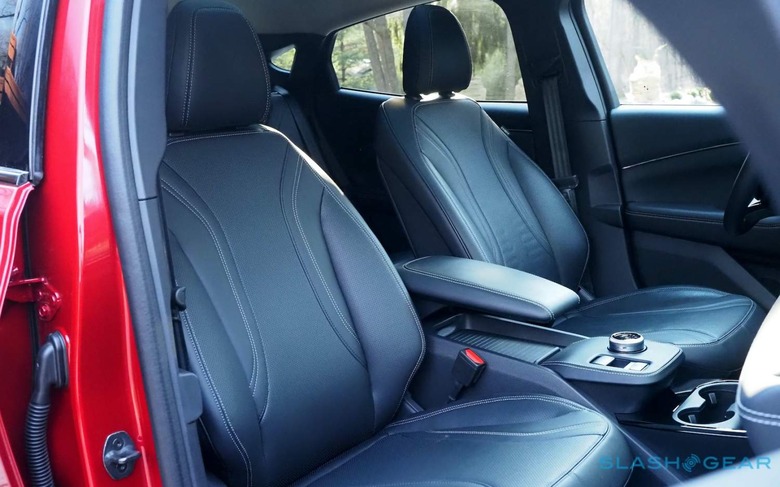
Dominating the dashboard, of course, is the big touchscreen display. It's cantilevered out so that it looks like it's floating, a 15.5-inch high-resolution panel that looks great and feels very responsive. There are light and dark versions of the UI – which can switch over automatically, or be manually selected – and all of the touch points are large and easily stabbed-at while you're focusing on the road.
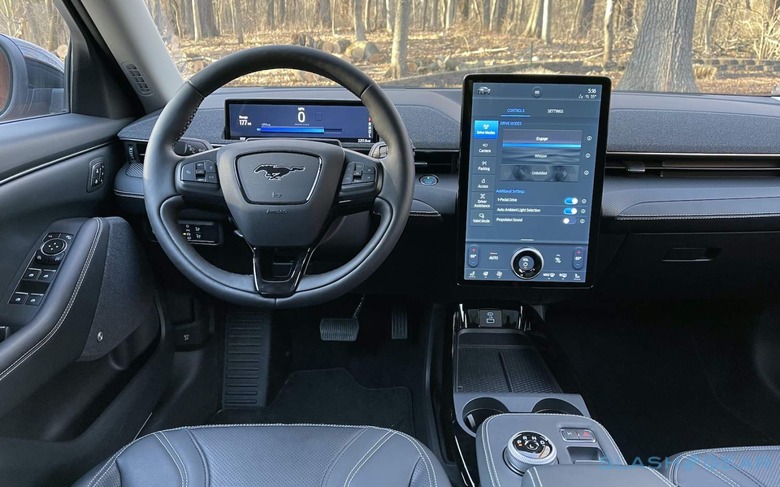
There are a few physical controls still, not least the volume knob fixed to the lower center section of the touchscreen. I would've preferred to see a drive mode selector alongside the rotary transmission knob, rather than picking them from the settings menu.
Ford's latest Sync OS effectively splits the touchscreen into three sections. At the bottom there's a persistent HVAC section, while the upper half of the screen is for the active app. The section in-between shows a row of "cards": basically widgets that also act as shortcuts to different functions. The media card, for instance, will show the current radio station or track playing; tapping it will open the full app above. Then, you can hit the 'maximize' icon in the upper right corner, and have it expand to cover the cards section too.
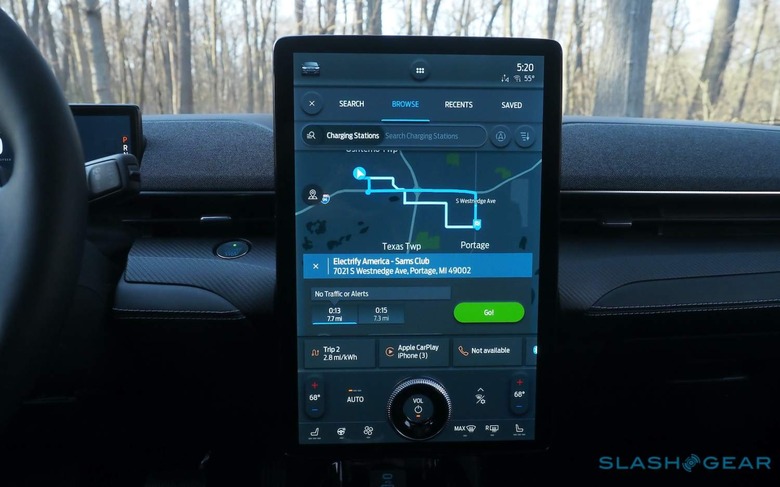
In theory, the cards you see should auto-curate over time. I suspect I would've needed longer in the Mustang Mach-E's company for that to start happening. Wireless Apple CarPlay and Android Auto get cards too, so you can flip between your smartphone's interface and other vehicle menus. The disparity in UI styles between Ford, Apple, and Google can leave the whole thing looking a little hectic, but I like how easy it is to jump in-between. A Qi wireless charging pad underneath the touchscreen is just big enough to fit an iPhone 12 Pro Max, and there are several USB ports – both Type-A and Type-C – front and rear.
Tapping the car icon in the upper left corner of the touchscreen brings up the controls and settings menus. First off you see the three drive modes – Whisper, Engage, and Unbridled – and the toggles to turn one-pedal driving and the car's "propulsion sound" on or off. Elsewhere there are the auto-park features, the external cameras, and options for the driver assistance tech.
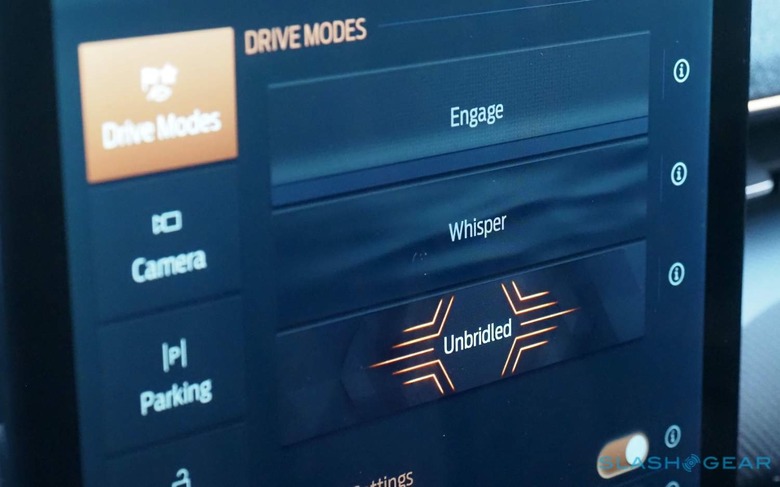
Finally, the app launcher button in the center of the title bar is where you find shortcuts to the radio, phone, navigation, owner's manual, and apps like Waze and TIDAL. Sync will also put suggested actions there too, depending on the time of day. In the evening, for example, it might offer to help you park the car or find a nearby charger.
The other display is a 10.2-inch panel for the driver's instrumentation. It's a lot more straightforward in what it shows: basically speed, battery charge and remaining range, and other essentials. Each of the three drive modes get a different theme and animations.
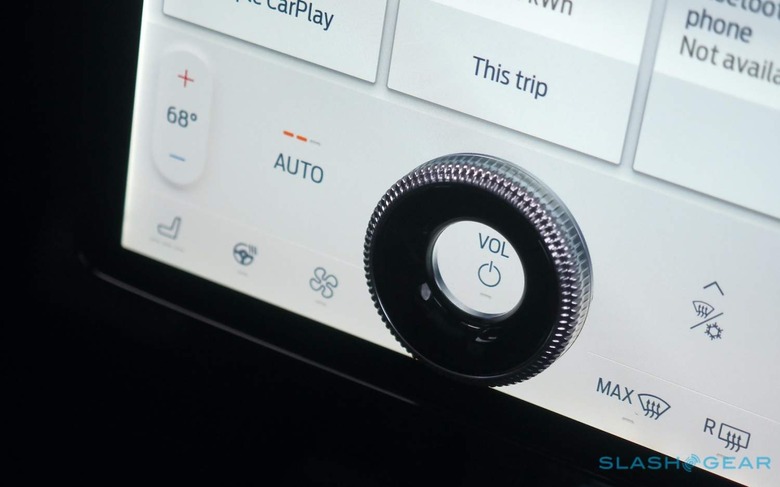
Mustang Mach-E price and performance
The Mustang Mach-E line-up kicks off at $42,895 (plus $1,100 destination, but before any incentives) for the Select trim, though my particular car was the 2021 Mustang Mach-E Premium AWD with the extended range battery. Premium trim starts at $47,000 with a 68 kWh battery and rear-wheel drive; adding all-wheel drive is another $2,700. The RWD car with the extended range, 88 kWh battery starts at $52,000, or from $54,700 with AWD.
Because Ford still qualifies – for now – for the $7,500 US federal tax incentive, most buyers will be able to knock that amount off the sticker. There are also various state and local incentives and rebates that can help tame the price tag too. Still, it means the Mustang Mach-E pretty much takes on the Tesla Model Y head-on for price, as you'd expect.
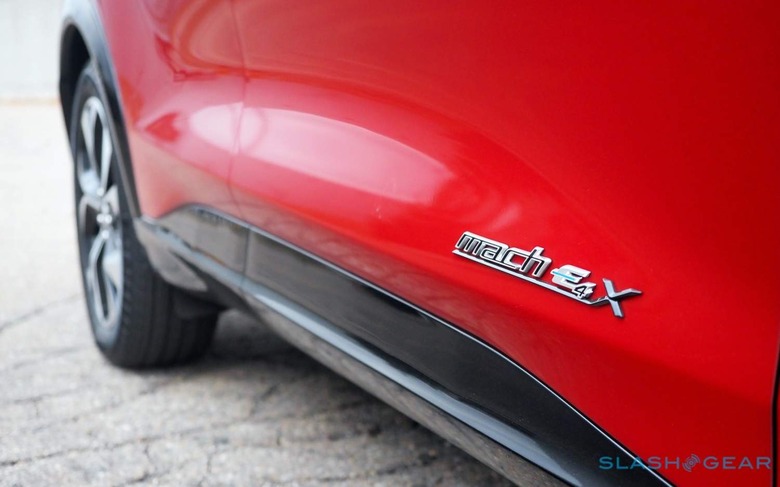
With two electric motors and the 88 kWh battery, Ford and the EPA rate the Premium trim EV for 270 miles. If you can do without all-wheel drive, the RWD version nudges range up to 300 miles; with the standard battery, it's 230 miles for RWD or just 211 miles for AWD.
AWD and the extended range battery gets you the most speed: 0-60 mph comes in 4.8 seconds, and there's 346 horsepower (258 kW) to play with. At the moment it's the fastest of the bunch, up until the Mustang Mach-E GT models arrive late this summer. That'll trim the 0-60 time to under four seconds, Ford promises.
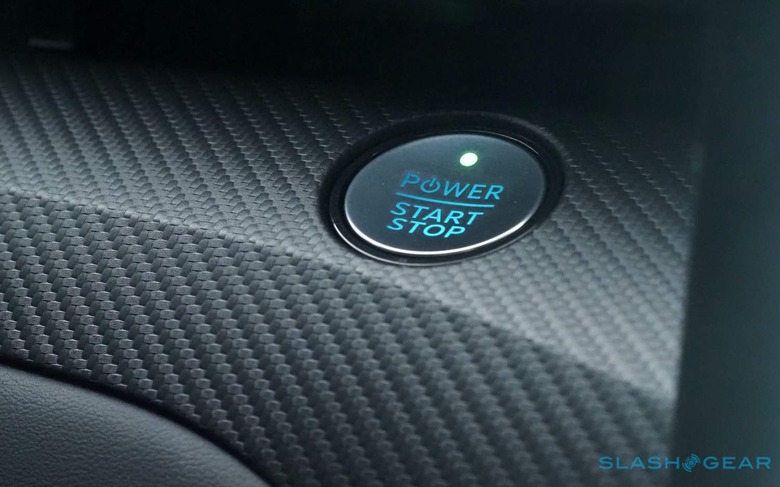
It'll be a whole lot of fun, I'm sure, but the Premium AWD is no slouch. The default drive mode is Engage, which you could think of as the equivalent of Normal mode in other cars; Whisper is the Eco mode, while Unbridled is Sport. Each can have one-pedal mode toggled on or off.
As is usually the case with electric cars, that first stab of the accelerator is enough to put a smile on your face. All that instant torque leaves the Mach-E feeling more than perky: even if you're not burying the right pedal, the EV feels eager and belies the not-insignificant curb weight from all those batteries. Engage mode is great for point-and-squirt urban driving, fast off the mark for when the lights change, but not so urgent as to leave you lurching.
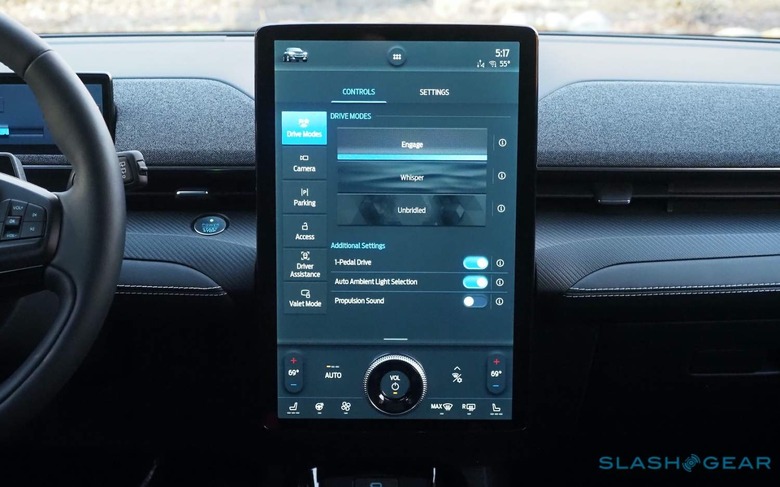
Flip to Unbridled, meanwhile, and the Mach-E gets more profligate with its electrons. The height and weight mean this isn't going to sashay through the corners as evenly and aggressively as a Mustang coupe might, but that's not to say it's lacking in grip or poise. The relatively low center of gravity helps keep things stable, albeit stiff over poor quality roads, and it's fun even if not ferocious. As with driving big, luxury sedans fast, the best strategy is to brake hard into the corners and then rely on lashings of torque to get you back up to speed once you're safely around; trying to carry too much pace can be unnerving.
Mustang Mach-E range and charging
Just how much range is "enough" is a tricky question to answer. There's the rational, statistics-led approach, which says the average driver in the US does about 40 miles a day, or the paranoid other extreme where you can't imagine settling for less than 350 miles. Tesla aside, most EVs available in the US seem to have settled somewhere in the 200-300 mile bracket.
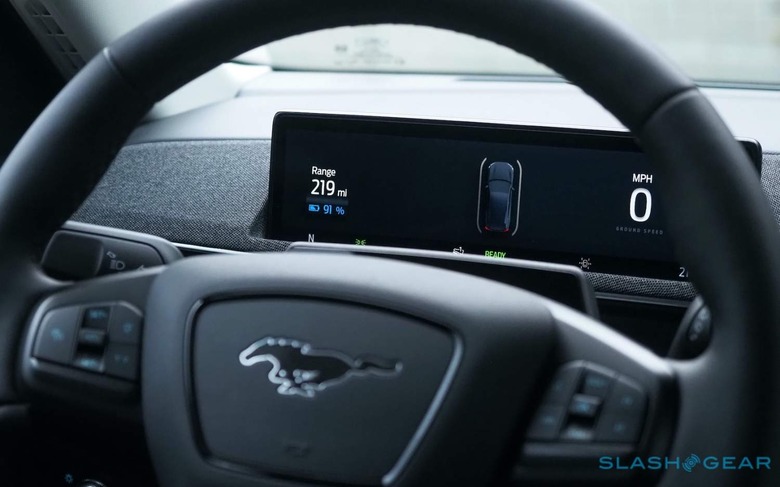
Personally I'm of a mind that, as long as you have access to a Level 2 240V charger at home, then the important factor is how accurate the battery estimate in your electric vehicle is. You'd think that would be table-stakes, but in reality some EVs are much more proficient than others at telling you just how far you'll be able to go on what charge is remaining. If you know you can trust that estimate, you're less likely to stress out when you have to run errands but the meter says you're down to double-digits.
The good news is, Ford's algorithms are clearly doing excellent work in the background. The Mustang Mach-E's range estimate was always within a mile or so of my actual driving on each trip.
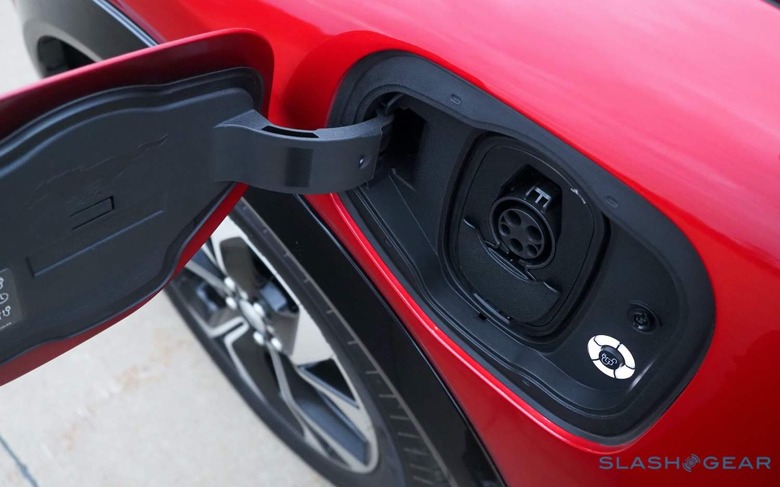
When it does come time to charge, most EV-owners do that at home. Ford includes a charger with dual 120V/240V support: it'll work on a regular outlet, though only add around 3 miles of range per hour plugged in, or with a 30A NEMA 14-50 outlet for much faster top-ups. Assuming you have one of those, you're looking at around 20 miles added per hour.
Of course, any Level 2 charger up to 240V/48A will work too, for up to 28 miles of range added per charging hour. Basically, as long as it has a J1772 plug on the end, you'll be able to use it with the Ford.
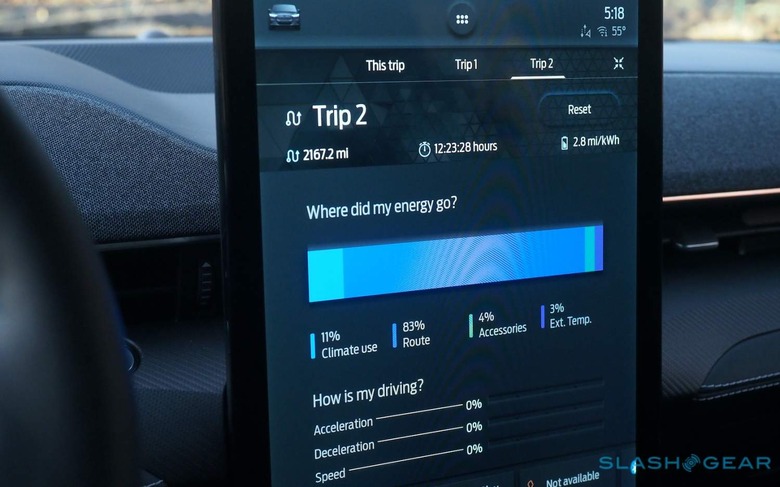
Where things get more challenging is when you need to charge away from home. The Mustang Mach-E supports up to 150kW DC fast charging: with a suitably potent station, you could add 59 miles of range in 10 minutes. Here's the part where I say that, if you had a Tesla, you'd hit the button to find the nearest Supercharger and head over there, pretty confident in knowing that you could get a fast top-up.
Ford doesn't have its own charging network: instead it has the FordPass Charging Network, which sounds like it would be the same thing but really isn't. Instead, it attempts to gather public chargers from different third-party networks under the same umbrella, with universal search integrated into both the Mustang Mach-E's navigation and Ford's smartphone app.
There are 16,000+ chargers in that database, and if you use the EV's voice control system to "find me a charging station" it'll offer you a list of the five that are closest and give you directions to them. Problem is, exactly what you'll find when you get there can vary considerably.
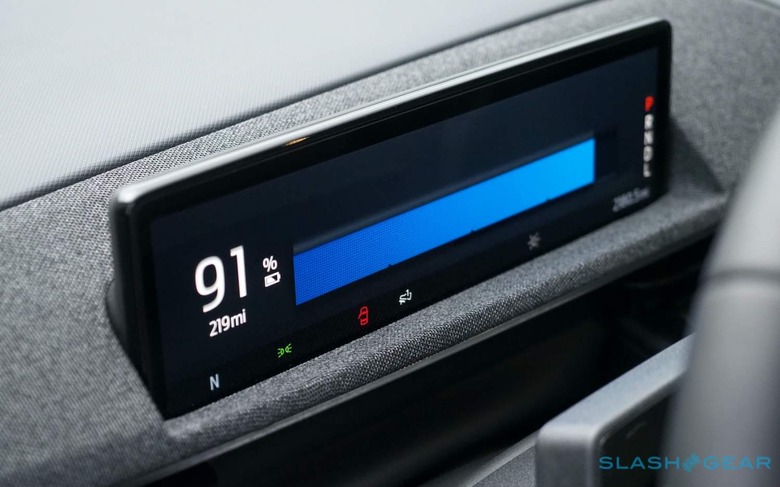
Most offer Level 2 charging, so about as fast as a decent home charger. A smaller percentage are DC fast chargers, though while 150 kW or upwards is increasingly common, some still deliver more like 50-100 kW. Running into a slow or just plain broken charger is more of a headache than stumbling on an out-of-order gas pump, of course, as typically it's easier to find another source of fuel for your combustion-powered car.
Some of the frustrations could be fairly readily addressed. The voice control system, for example, doesn't recognize "find me a DC fast charging station" to filter out just the speediest chargers. Instead, you have to manually tap through the filters in the map, where you can refine by Fast Charge only (and by available and open, along with only showing those in-network for FordPass). The app, in contrast, defaults to the opposite behavior, filtering to show only the in-network DC fast chargers unless you request otherwise.
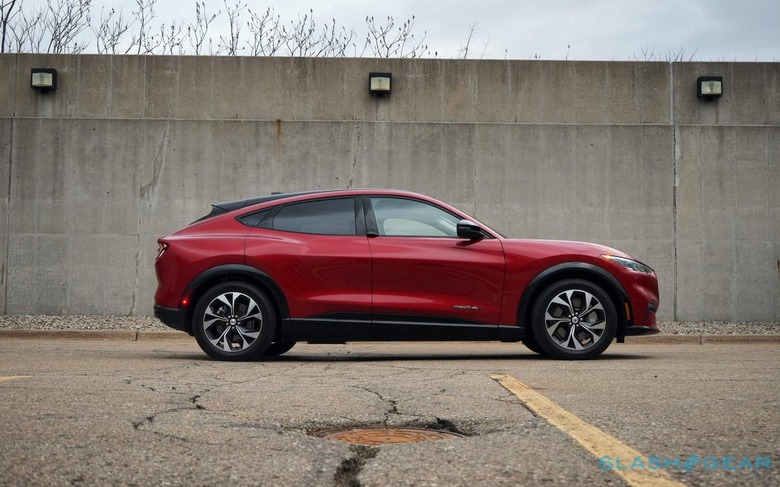
If you're lucky enough to find an Electrify America Fast Charger, they support Plug & Charge. Basically, just plugging the car in should be enough for everything to authenticate and the session to begin. Other locations, though, usually require you to find them in the FordPass app after plugging in, pinpoint which of the chargers there you're trying to use, and activate manually.
I'm of a mind that, while automakers, networks, and policy makers do clearly need to do more when it comes to filling out the public charging infrastructure, that shouldn't necessarily be a deal-breaker to you if you're considering an EV. If you've got somewhere to park it and plug it in at home, there's a strong chance that will sort 99-percent of your charging needs. The occasional longer trip may need some planning to figure out the fastest public chargers along the route, but that's the exception to electric car ownership for most people, not the rule.
But is the Mustang Mach-E a "real" Mustang?
Some people are tremendously angry that the Mustang Mach-E is part of the Mustang family. "True" Mustangs, they point out, are two door coupes or convertibles. They have big gas engines, and preferably manual transmissions, They're cars with soul, not electricity.
And look, I get it. I love a big displacement, loud, feisty engine too. I love cars with tailpipes that howl with personality, and silky stick-shifts that go snick-snick-snick, and that sense that mechanical magic is going on as the stars and fates align to produce ample speed and sticky cornering.
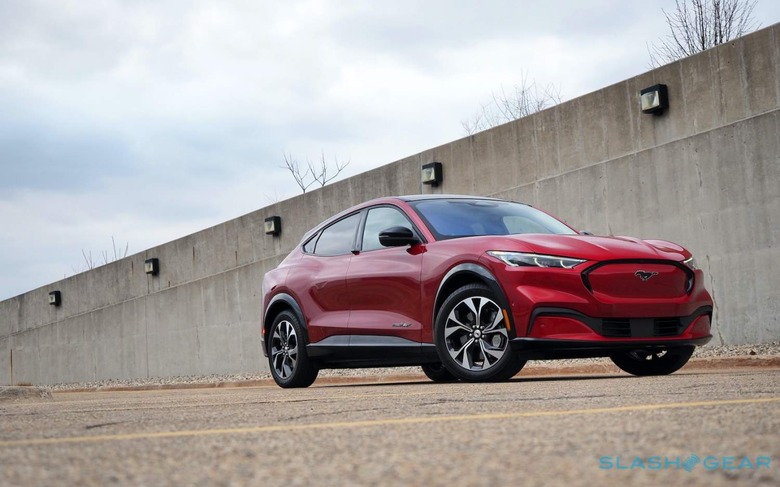
I also think, though, that many people are losing track of what the Mustang has always stood for. Attainable performance, and the democratization of it. Distilling what was once only available for those with deep-pockets or a willingness to suffer through patchy reliability, and turning it into a car you can commute in every day but still have fun with at the weekend.
The big V8 engines that came to epitomize the Mustang were Ford's reliable workhorses. And since then, each successive iteration of coupes and convertibles has followed a similar strategy of picking the best of the cutting-edge and making it available to the mass market. Seen from that perspective, the Mach-E is every bit a Mustang.
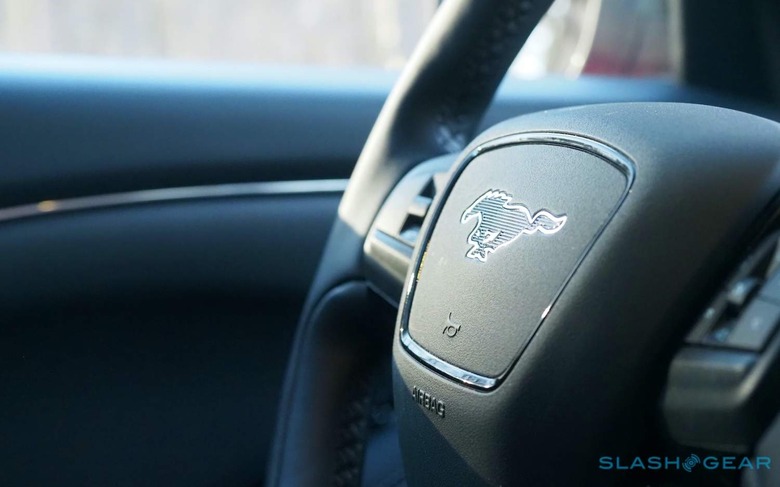
Ford could've given itself an easier time had it followed its initial plan and opted for a different name. Then again, many of the conversations I had with people during my time with the Mach-E were triggered because "huh, is that a Mustang?" was their first reaction. Maybe the hardcore enthusiasts will be tougher to win over, but for getting the word out that Ford is taking electrification seriously, the nameplate seems a cunningly-correct choice.
Still to come, Ford Active Drive Assist and the Mach-E GT
Arguably the Mach-E's most interesting feature isn't available yet, though Ford will let you pay for at least part of it. Active Drive Assist is the company's alternative to GM Super Cruise, hands-off driver-assistance for the highway. As with GM's system, it uses an attention-monitoring camera on the steering column to make sure you're paying attention to the mapped divided highways it's designed to work on.
As long as it's content that you're engaged, even if your hands aren't touching the wheel, it promises to keep pace with traffic ahead and maintain your position in the lane. Unfortunately, Active Drive Assist won't be ready until sometime in Q3 2021, Ford says, though to avoid penalizing Mach-E early adopters it's been offering the hardware now with the promise of OTA software to come later. Expect to pay $600 for the software once it's ready, and then a subscription after the first three years.
All but Select trim cars have the hardware installed as standard. It's part of the optional Ford Co-Pilot360 Active 2.0 Prep Package on the entry-level EV. For the moment, you get a more standard hands-on adaptive cruise control system with lane-assistance.
The other big thing to come is the Mustang Mach-E GT. In fact, Ford will have two versions of its most potent EV: the GT and the GT Performance. The latter will cut the GT's 0-60 mph time from 3.8 seconds to 3.5 seconds, while bumping torque from 600 lb-ft to 634 lb-ft. AWD will be standard, and both crossovers will have 480 horsepower.
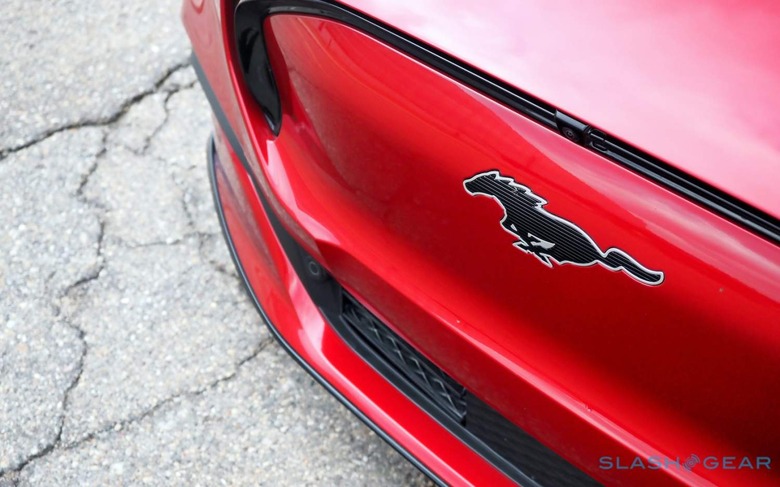
There'll be a hit on range, unsurprisingly, for the fastest Mach-E. The GT is expected to do 250 miles on its standard 88 kWh battery; the GT Performance will dip to 235 miles. Both are expected to arrive from summer 2021.
2021 Ford Mustang Mach-E Verdict
I honestly don't care that Ford decided to brand this car a Mustang. Like I said about the C8 Corvette last year, not having been brought up in the US means some of the charms of Americana just don't give me the same warm'n'fuzzies. What seems far more important is how seriously Ford has taken the Mustang Mach-E, and if entrusting it with its most precious nameplate is evidence of that commitment then I'm onboard.
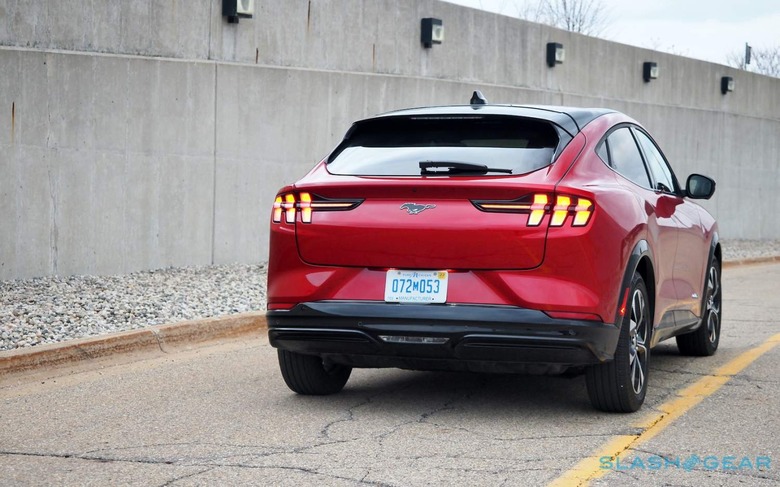
And make no mistake, the Mach-E is a serious, competitive electric car. Sure, it doesn't match the Model Y in range, and we'll have to wait for the GT Performance for true Tesla-rivaling power, but for the sort of mainstream audience Ford has in mind they're nowhere near deal-breakers. This isn't a grudgingly-made, apologetic EV; it doesn't feel performative or half-assed.
Soon it'll be joined by an all-electric F-150, and an eTransit, and if you needed more convincing that Ford is going all-in on electrification then EV versions of its best-selling truck and best-selling van should be more than enough. They're not only vehicles that hundreds of thousands of people buy every year in the US alone, but vehicles that carry strong preconceptions. If a "real" F-150 can also be electric, that's hugely disruptive.
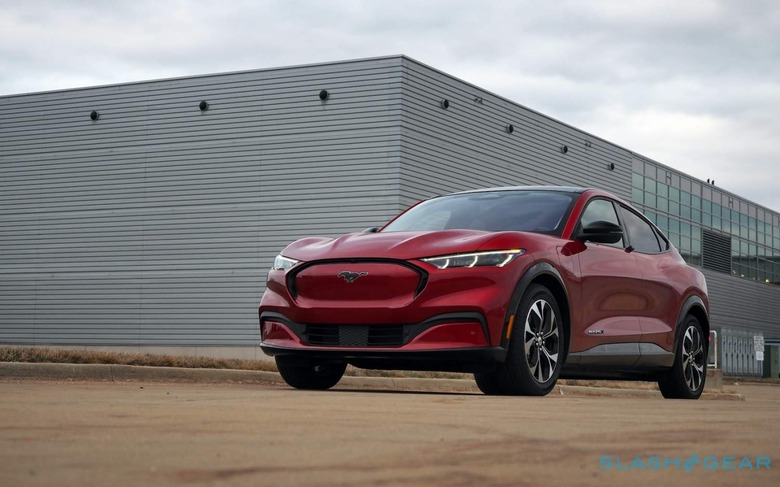
For now, though, the weight of Ford's EV ambitions rest on the Mustang Mach-E's capable shoulders. Imperfect but highly appealing, it wraps the cutting-edge in the reassuring familiarity of the blue oval. It's often been said that electric cars and electric car infrastructure are a chicken and egg situation: public charging isn't going to be taken seriously until the vehicles that demand it reach the mainstream. I suspect the Mach-E could be the heavyweight chicken that cracks that egg right open.
